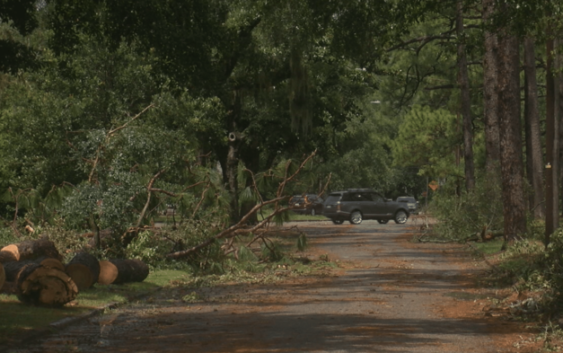- One set of evacuation orders lifted in Caldwell County after wildfire contained
- 'We gutted every building' | Chimney Rock rebuilding after Hurricane Helene
- 'We gutted every building' | Chimney Rock rebuilding after Hurricane Helene
- Debris from Hurricane Helene provides fuel, complicates containment for spring wildfires
- David & Nicole Tepper increase Hurricane Helene relief commitment to $750k
New Hanover County’s hurricane debris collection halfway complete

NEW HANOVER COUNTY, NC (WWAY) — New Hanover County has collected more than 104,000 cubic yards of vegetative debris from Hurricane Isaias since August 10, and is expected to complete debris collection in the unincorporated areas of the county by the end of September.
Residents have also been able to bring storm-related debris to the landfill at no cost, but the last day to do so will be Monday.
The landfill will operate regular hours, 6:30 a.m. to 5 p.m., on Monday, September 7, which is also Labor Day. Fees for storm-related vegetative, construction and demolition debris will resume on Tuesday, September 8.
Vegetative debris collection will continue until the completion of two passes in the unincorporated areas of the county. A progress map of debris collection and other information can be found at Recycling.NHCov.com.
DAMAGE REPORTING AND REPAIRS
Additionally, residents who sustained property damage from Hurricane Isaias can still submit a property damage report to the New Hanover County Tax Department at Tax.NHCgov.com. Properties that have major damage and repairs not completed by December 31, 2020 may be considered for an adjustment for the 2021 tax year. This will not apply to current tax bills, but may apply to tax bills for next year.
Building permits related to storm damage from Hurricane Isaias continue to be provided by the county at no cost until further notice. To date, about 81 free repair permits have been issued in response to Hurricane Isaias. The county’s Building Safety Department at the Government Center is open Monday-Friday, 7:30 a.m.-5 p.m. and can be reached at 910-798-7308.
SEPTEMBER IS NATIONAL DISASTER PREPAREDNESS MONTH
Each September, National Preparedness Month is recognized to promote family and community disaster planning now and through the year. This year’s theme, “Disasters Don’t Wait. Make Your Plan Today,” focuses on four main areas of preparedness:
- Make a Plan
Talk to your friends and family about how you will communicate before, during, and after a disaster like a hurricane. Make sure to update your plan based on what we know about COVID-19. Identify a safe place to go inland, like a hotel or friend or family member’s home safer than your own. Consider ways to safely expand your circle of interaction amid COVID-19, by maintaining social distancing, staying in one space as much as possible and bringing your own amenities like food and bedding. Any community sheltering option should be considered a last resort.
- Build a Kit
Gather supplies that will last for several days after a disaster for everyone living in your home. Don’t forget to consider the unique needs each person or pet may have in case you have to evacuate quickly. In addition to emergency supplies like food, water, batteries, medications, pet supplies, important documents and other needs, add items like face coverings and hand sanitizer to kits this year. Your emergency kit should include enough supplies for five to seven days.
- Prepare for Disasters
Limit the impacts that disasters have on you and your family. Know the risk of disasters in the area, like hurricanes, flooding and other risks, and check your insurance coverage. Learn how to make your home stronger in the face of storms and other common hazards and act fast if you receive a local warning or alert.
- Teach Youth About Preparedness
Talk to your kids about preparing for emergencies and what to do in case you are separated. Reassure them by providing information about how they can get involved.
Visit ReadyNHC.com to learn about local hazards that could impact our area, register for emergency alerts, sign up for New Hanover County emergency news updates and subscribe to National Weather Service updates.